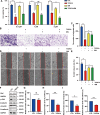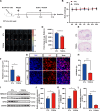Taurochenodeoxycholic acid suppresses the progression of glioblastoma via HMGCS1/HMGCR/GPX4 signaling pathway in vitro and in vivo
- PMID: 40264142
- PMCID: PMC12016240
- DOI: 10.1186/s12935-025-03782-2
Taurochenodeoxycholic acid suppresses the progression of glioblastoma via HMGCS1/HMGCR/GPX4 signaling pathway in vitro and in vivo
Abstract
Glioblastoma multiforme (GBM) is the foremost prevalent and highly aggressive intracranial malignancy, which urgently needs safer and more efficacious therapeutic strategies. Our research aimed to investigate the impact and the underlying mechanism of Taurochenodeoxycholic acid (TCDCA) on GBM. In this study, we explored the suppressive effect of TCDCA in vitro by qualification of proliferation and migration assays and flow cytometry, and subsequently predicted the potential anti-GBM mechanism of TCDCA by mRNA sequencing and the following rescue experiments. An orthotopic GBM model in C57BL/6 mice further demonstrated the anti-GBM mechanism of TCDCA. In vitro experiments verified that TCDCA inhibited the growth and migration of GBM cells and induced cell cycle arrest at the G2/M phase. Subsequent mechanism investigations showed that upregulation of HMGCS1 and HMGCR and downregulation of glutathione peroxidase-4 (GPX4) was observed in GBM cells by TCDCA treatment. Notably, inhibitory effects of proliferation and migration as well as induction of ferroptosis by TCDCA were partially restored by Simvastatin (SIN), a competitive HMGCR inhibitor. Furthermore, TCDCA showed an anti-GBM effect in an orthotopic transplantation model in vivo. TCDCA impedes GBM progression by virtue of this intricately orchestrated molecular cascade, through HMGCS1/HMGCR/GPX4 signaling axis, thus unveiling a novel therapeutic avenue warranting further scrutiny in the treatment landscape of GBM.
Keywords: Ferroptosis; Glioblastoma multiforme; HMGCR; Migration; Proliferation; Taurochenodeoxycholic acid.
© 2025. The Author(s).
Conflict of interest statement
Declarations. Ethics approval and consent to participate: The Animal Care and Use Committee at Hangzhou Normal University granted consent to all animal research, and the approval number is HSD20220105. Competing interests: The authors declare no competing interests.
Figures








Similar articles
-
Intracellular C5aR1 inhibits ferroptosis in glioblastoma through METTL3-dependent m6A methylation of GPX4.Cell Death Dis. 2024 Oct 5;15(10):729. doi: 10.1038/s41419-024-06963-5. Cell Death Dis. 2024. PMID: 39368999 Free PMC article.
-
Taurochenodeoxycholic acid inhibits the proliferation and invasion of gastric cancer and induces its apoptosis.J Food Biochem. 2022 Mar;46(3):e13866. doi: 10.1111/jfbc.13866. Epub 2021 Jul 18. J Food Biochem. 2022. PMID: 34278593
-
Longikaurin A induces ferroptosis and inhibits glioblastoma progression through DNA methylation - Mediated GPX4 suppression.Eur J Pharmacol. 2024 Dec 5;984:177061. doi: 10.1016/j.ejphar.2024.177061. Epub 2024 Oct 18. Eur J Pharmacol. 2024. PMID: 39426467
-
FOXP3 promote the progression of glioblastoma via inhibiting ferroptosis mediated by linc00857/miR-1290/GPX4 axis.Cell Death Dis. 2024 Apr 1;15(4):239. doi: 10.1038/s41419-024-06619-4. Cell Death Dis. 2024. PMID: 38561331 Free PMC article.
-
Transcriptome investigation of anti-inflammation and immuno-regulation mechanism of taurochenodeoxycholic acid.BMC Pharmacol Toxicol. 2021 Apr 29;22(1):23. doi: 10.1186/s40360-021-00491-0. BMC Pharmacol Toxicol. 2021. PMID: 33926569 Free PMC article.
References
Grants and funding
LinkOut - more resources
Full Text Sources

